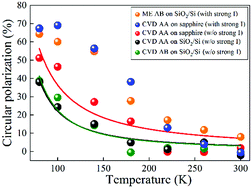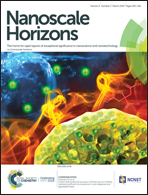Unveiling exceptionally robust valley contrast in AA- and AB-stacked bilayer WS2†
Abstract
Valleytronics is a particularly interesting field that employs the valley degree of freedom for information manipulation. The fascinating prospects for realizing valleytronic devices have inspired persistent efforts towards exploring material systems with robust valley polarization. Monolayer transition metal dichalcogenides (TMDs) obey the well-known valley-dependent selection rule as a result of their inversion asymmetry. However, for inversion-symmetric bilayer tungsten-based TMDs, highly selective valley polarization has been surprisingly observed and is not yet fully understood. Here we systematically study the origin of the anomalously high valley polarization in bilayer WS2 by temperature-dependent polarization-resolved photoluminescence measurements. It is found that acoustic phonons play a critical role in the valley polarization of bilayer WS2. For some WS2 bilayers with relatively small intensity ratios of indirect to direct bandgap emission, acoustic phonons could remarkably assist the intervalley scattering process and smear the valley contrast. On the other hand, in other bilayers, which show obvious indirect band gap emission, the indirect optical transition process depletes the phonon mode at the Λ point dramatically and results in anomalously robust valley polarization in bilayer WS2. These results help recognize the crucial role of electron–phonon coupling in intervalley relaxation in bilayer WS2 and provide new insights into the future design of valleytronic devices based on two-dimensional TMDs.



 Please wait while we load your content...
Please wait while we load your content...